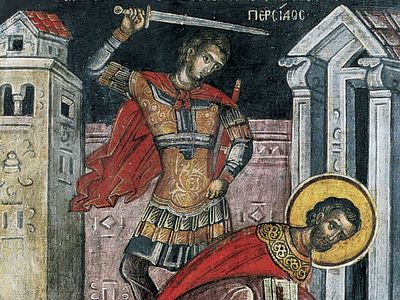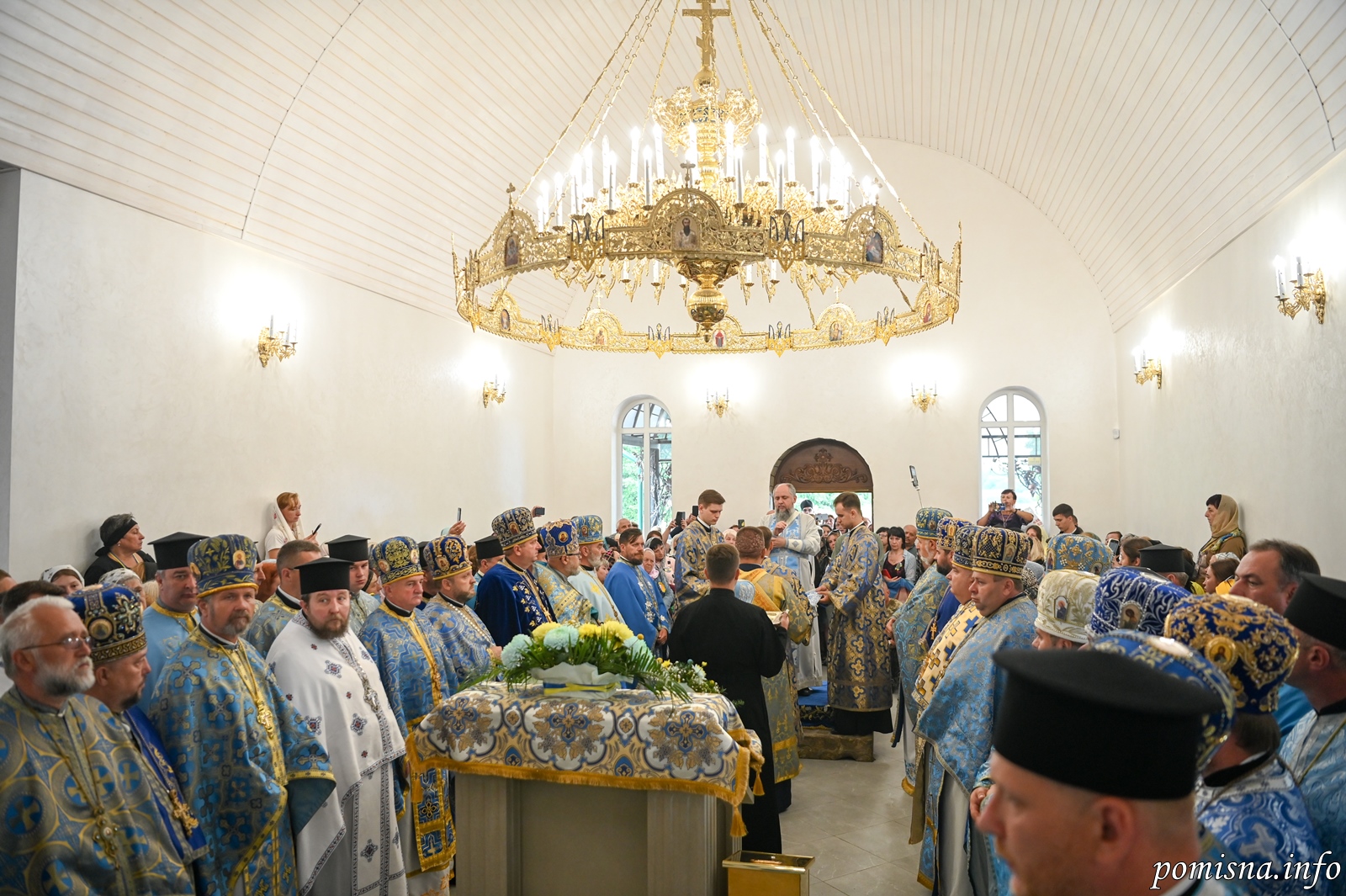Hieromartyr Simeon, Bishop in Persia, and those with him (17 April)


The Hieromartyr Simeon, Bishop of Persia, suffered during a persecution against Christians under the Persian emperor Sapor II (310-381). They accused the saint of collaborating with the Roman Empire and of subversive activities against the Persian emperor.
In the year 344, the emperor issued an edict which imposed a heavy tax upon Christians. When some of them refused to pay it, this was regarded as an act of rebellion, so the emperor began a fierce persecution against Christians.
Saint Simeon was brought to trial in iron fetters as a supposed enemy of the Persian realm, together with the two hieromartyrs Habdelai and Ananias. The holy bishop would not even bow to the emperor, who asked why he would not show him the proper respect. The saint answered, “Formerly, I bowed because of your rank, but now, when you ask me to renounce my God and abandon my faith, it is not proper for me to bow to you.”
The emperor urged him to worship the sun, and he threatened to eradicate Christianity in his land if he refused. But neither urgings nor threats could shake the steadfast saint, and they led him off to prison. Along the way the eunuch Usphazanes, a counsellor of the emperor, saw the saint. He stood up and bowed to the bishop, but the saint turned away from him because he, a former Christian, out of fear of the emperor, now worshipped the sun.
The eunuch repented with all his heart, he exchanged his fine attire for coarse garb, and sitting at the doors of the court, he cried out bitterly, “Woe to me, when I stand before my God, from Whom I am cut off. Here was Simeon, and he has turned his back on me!”
The emperor Sapor learned about the grief of his beloved tutor and asked him what had happened. He told the emperor that he bitterly regretted his apostasy and would no more worship the sun, but only the one true God. The emperor was surprised at the old man’s sudden decision, and he urged him not to abjure the gods whom their fathers had reverenced. But Usphazanes was unyielding, and they condemned him to death. Saint Usphazanes asked that the city heralds report that he died not for crimes against the emperor, but for being a Christian. The emperor granted his request.
Saint Simeon also learned about the death of Usphazanes, and he gave thanks to the Lord. When they brought him before the emperor a second time, Saint Simeon again refused to worship the pagan gods and confessed his faith in Christ. The enraged emperor gave orders to behead all the Christians in the prison before the saint’s eyes.
Without fear the Christians went to execution, blessed by the holy hierarch, and they bent their heads beneath the sword. Saint Simeon’s companion, the Priest Habdelai, was also beheaded. When they came to the Priest Ananias, he suddenly trembled. Then one of the dignitaries, Saint Phusicus (Pusicius), a secret Christian, was afraid that Ananias would renounce Christ, and he cried out, “Do not fear the sword, Elder, and you will see the divine light of our Lord Jesus Christ.”
Saint Phusicus betrayed himself by this outburst. The emperor gave orders to pluck out his tongue and to flay the skin off him. Along with Saint Phusicus, his daughter Askitrea was also martyred. Saint Simeon was the last to go before the executioner, and he placed his head on the chopping-block (April 13, 344). Executions continued all during Bright Week until April 23.
Saint Azates the Eunuch, a close official to the emperor, also received the crown of martyrdom, along with Saints Abdechalas, Usthazanes, and Azades. The sources indicate that 1,150 Martyrs perished because they refused to accept the Persian religion.
This Martyr was Bishop of the royal cities Seleucia and Ctesiphon in Persia. As the number of Christians increased in Persia, building churches and appointing clergy, the Magi, guardians of the Persian religion, and the Jews, who also envied them, accused Symeon to Sapor II, King of Persia, saying that Symeon was a friend of the Roman Emperor and his spy. Then began Sapor’s persecution of the Christians of Persia, about the year 343. The Magi together with the Jews destroyed the churches. Saint Symeon was brought before Sapor, and, refusing to worship the sun, was imprisoned. On Holy and Great Friday of that year, Saint Symeon was brought out of prison with a hundred others, bishops, priests, and deacons. As each was taken to be slain, Saint Symeon exhorted him to be of good courage; he was slain last of all. It is said that 1,150 Martyrs were slain; an innumerable multitude of Christians were slain throughout Persia during this persecution, among them Saints Acepsimas, Joseph, and Aethalas (see Nov. 3).
Apolytikion of Hieromartyr Symeon and those with him
Plagal of the First Tone
All the powers of Heaven were awestruck and amazed at the achievements and deeds of the holy Martyrs of Christ; for contending well in mortal bodies clothed with flesh, they overcame the fleshless foe by the power of the Cross and invisibly subdued him. And now they pray to the Lord, that He might bestow His mercy on our souls.
During the reign of the wicked King Sapor [Savori], Simeon was tortured for Christ along with his two presbyters, Audel and Ananias. The king’s eunuch, Ustazan–who had earlier denied Christ but afterward, touched by the rebuke of St. Simeon, had again confessed the true Faith before the king–was executed before them. A thousand other Christians were also led to the place of execution with Simeon. Simeon intentionally moved out of the way in order to be the last one beheaded. He did this to encourage the other Christians, so that not one of them would waver out of fear of death. When the presbyter Ananias placed his head on the chopping block, his entire body quivered. The king’s court clerk, Fusik, who secretly was a Christian, began to encourage Ananias saying: “Do not be afraid, old man, close your eyes and be brave, so that you may see the Divine Light.” As soon as Fusik said this, he was recognized as a Christian and was accused before the king. Both Fusik and his daughter, the maiden Askitria, were exhausted through great torture by the king. After St. Simeon saw his flock depart to the other world, he was finally beheaded. The following year on Great Friday, Azat [Ustazan], the beloved eunuch of the king, was also slain for Christ and with him a thousand other faithful. Then the emperor mourned for his eunuch and suspended the further killing of Christians. They all suffered honorably for Christ the King and Lord in the year 341 or 344 A.D.
Source: oca.org / goarch.org / westserbdio.org




